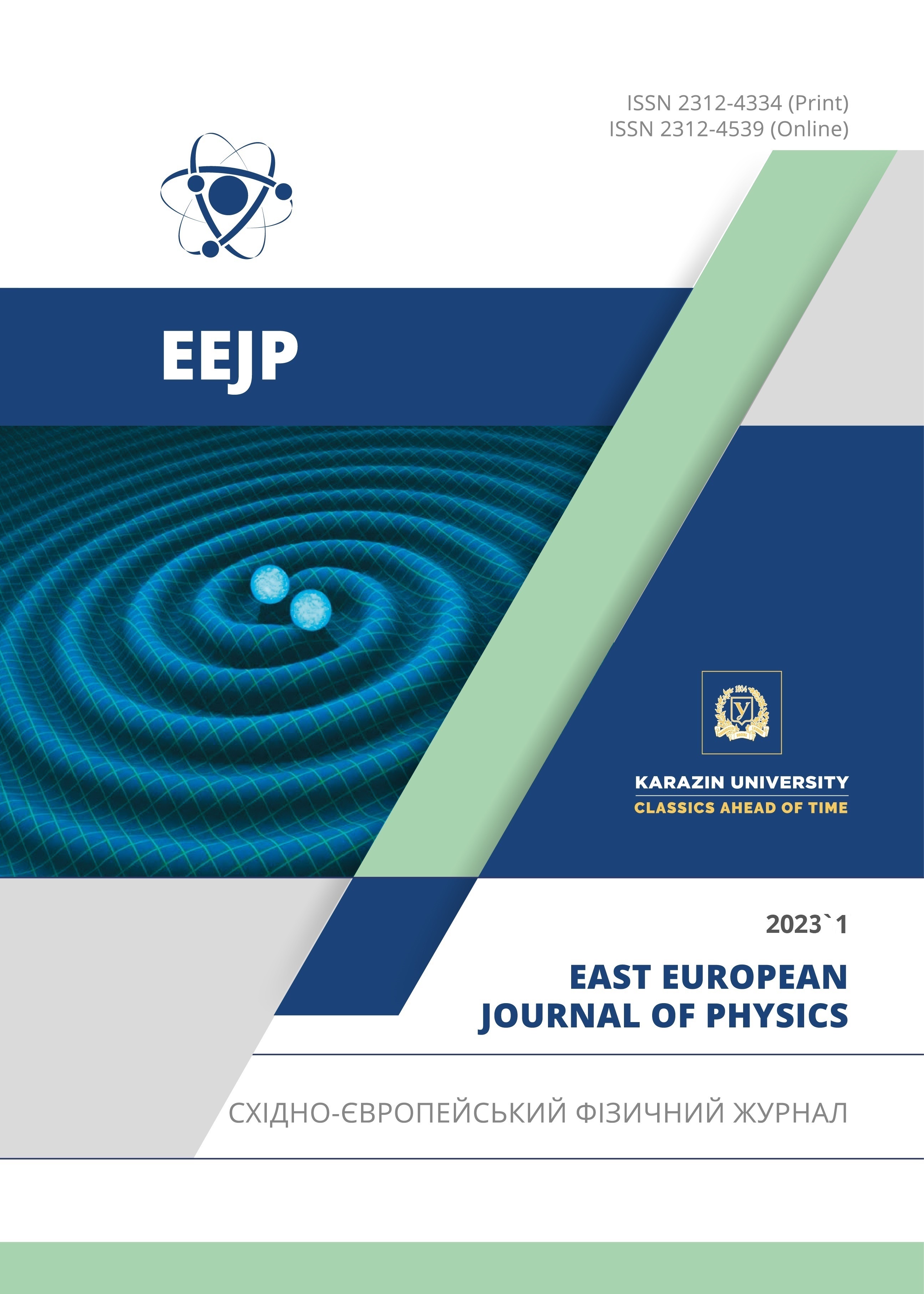Дробове рівняння Шредінгера з узагальненим потенціалом Вудса-Саксона
Анотація
Власні значення енергії зв'язаного стану та відповідні власні функції узагальненого потенціалу Вудса-Саксона, наведені в [Phys. Rev. C, 72, 027001 (2005)] поширюється на дробові форми з використанням узагальненої дробової похідної та дробової методики Нікіфорова-Уварова (NU). Отримано аналітичні розв’язки зв’язаних станів рівняння Шредінгера для наявного потенціалу в термінах дробових поліномів Якобі. Продемонстровано, що класичні результати є окремим випадком сучасних результатів при α=β=1 , тому ці результати відіграють важливу роль у молекулярній хімії та ядерній фізиці.
Завантаження
Посилання
R. Hilfer, Applications of fractional calculus in physics, (World Scientific, 2010).
J. Banerjee, U. Ghosh, S. Sarkar, S. Das, and Pramana, J. Phys. 88, 70 (2017). https://doi.org/10.1007/s12043-017-1368-1
M. Nouzid, M. Merad, and D. Baleanu, Few–Body Syst. 57, 265 (2016). https://arxiv.org/ftp/arxiv/papers/2103/2103.14064.pdf
N. Laskin, Phys. Rev. E, 62, 3135 (2000). https://doi.org/10.1103/PhysRevE.62.3135
N. Laskin, Phys. Lett. A, 268, 298 (2000). https://doi.org/10.1016/S0375-9601(00)00201-2
H. Karayer, D. Demirhan, and F. Buyukkilic, Commun. Theor. Phys. 66, 12 (2016). https://doi.org/10.1088/0253-6102/66/1/012
H. Karayer, D. Demirhan, and F. Buyukkilic, Adv. Theor. Math. Phys. 19, 701 (2015). https://arxiv.org/pdf/1703.03234.pdf
D. Baleanu, K. Diethelm, E. Scalas, and J.J. Trujillo, Fractional Calculus Models and Numerical Methods, (World Scientific, 2012).
A. Al-Jamel, Int. J. Mod. Phys. A, 34, 1950054 (2019). https://doi.org/10.1142/S0217751X19500544
M. Abu-Shady, Inter. J. Modern Phys. A, 34, 31, 1950201 (2019). https://doi.org/10.1142/S0217751X19502014
M. Abu-Shady, and Sh. Y. Ezz-Alarab. Few-Body Systems, 62, 13, (2021). https://doi.org/10.1007/s00601-021-01591-7
M. Abu-shady; Azar I. Ahmadov; He M. Fath-Allah; Vatan H. Badalov, Journal of Theoretical and Applied Physics, 16(3), 1 (2022). https://doi.org/10.30495/jtap.162225
W.S. Chung, J. Comput. Appl. Math. 290, 150 (2015). https://doi.org/10.1016/j.cam.2015.04.049
T. Tas, U. Ghosh, S. Sarkar, and S. Das, J. Math, Phys. 59, 022111 (2018). https://doi.org/10.1063/1.4999262
M. Abu-Shady, and M.K.A. Kaabar, Mathematical Problems in Engineering, 2021, (2021). https://doi.org/10.1155/2021/9444803
M. Abu-Shady, and M.K.A. Kaabar, Computational and Mathematical Methods in Medicine, 2022, 2138775 (2022). https://doi.org/10.1155/2022/2138775
M. Abu-Shady, and E.P. Inyang, East Eur. J. Phys. 4, 80-86 (2022). https://periodicals.karazin.ua/eejp/article/view/20419
M. Abu-Shady, and E.M. Khokha, Molecular Physics, 120:24 (2022), https://doi.org/10.1080/00268976.2022.2140720
M. Abu-Shady et al. “Fractional Effective Quark-Antiquark Interaction in Symplectic Quantum Mechanics”, (2022). https://doi.org/10.48550/arXiv.2209.12083
R.D. Woods, and D.S. Saxon, Phys. Rev. 95, 577 (1954). https://doi.org/10.1103/PhysRev.95.577
N. Wang, and W. Scheid, Phys. Rev. C, 78, 014607 (2008). https://doi.org/10.1103/PhysRevC.78.014607
S. Ikhdair, and R. Sever, Open Physics, 8(4), 52-666 (2010). https://doi.org/10.2478/s11534-009-0118-5
S. Ikhdair, B.J. Falaye, and M. Hamzavi, Chinese Phys. Lett. 30, 020305 (2013). https://doi.org/10.1088/0256-307X/30/2/020305
C. Berkdemir, A. Berkdemir, and R. Sever, Phys. Rev. C, 72(2), 027001 (2005). https://doi.org/10.1103/PhysRevC.72.027001
C.M. Perey, F.G. Perey, J.K. Dickens, and R.J. Silva, Phys. Rev. 175, 1460 (1968). https://doi.org/10.1103/PhysRev.175.1460
M. Abu-Shady, and A.N. Ikot, Eur. Phys. J. Plus, 134, 321 (2019). https://doi.org/10.1140/epjp/i2019-12685-y
M. Abu-Shady, T.A. Abdel-Karim, and E.M. Khokha, Advances in High Energy Physics, 2018, 7356843 (2018). https://doi.org/10.1155/2018/7356843
M. Abu-Shady, H.M. Mansour, and A.I. Ahmadov, Advances in High Energy Physics, 2019, 4785615 (2019). https://doi.org/10.1155/2019/4785615
S.B. Doma, M. Abu-Shady, F.N. El-Gammal, and A. Amer, Molecular Physics, 114, 11 1787 (2016). https://doi.org/10.1080/00268976.2016.1154198
E.P. Inyang, and E.O. Obisung. East Eur. J. Phys. 3, 32 (2022). https://doi.org/10.26565/2312-4334-2022-3-04
E.P. Inyang, P.C. Iwuji, J.E. Ntibi, E. Omugbe, E.A. Ibanga, and E.S. William, East Eur. J. Phys. 2, 51 (2022). https://doi.org/10.26565/2312-4334-2022-2-05
E.P. Inyang, P.C. Iwuji, J.E. Ntibi, E.S. William, and E.A. Ibanga, East Eur. J. Phys. 2, 12 (2022). https://doi.org/10.26565/2312-4334-2022-2-02
E.P. Inyang, E.O. Obisung, P.C. Iwuji, J.E. Ntibi, J. Amajama, and E.S. William, J. Nig. Soc. Phys. Sci. 4 (2022) https://doi.org/884.10.46481/jnsps.2022.884
E.P. Inyang, E.O. Obisung, E.S. William, and I.B. Okon, East Eur. J. Phys. 3, 114 (2022). https://doi.org/10.26565/2312-4334-2022-3-14
E.P. Inyang, E.O. Obisung, J. Amajama, D.E. Bassey, E.S. William, and I.B. Okon, Eurasian Physical Technical Journal, 19, (4 (42)), (2022) 78-87. https://doi.org/10.31489/2022No4/78-87
E.P. Inyang, E.P. Inyang, I.O. Akpan, J.E. Ntibi, and E.S. William, Canadian J. Phys. (2021). https://doi.org/10.1139/cjp-2020-0578
E.P. Inyang, J. Ntibi, E.A. Ibanga, F. Ayedun, E.P. Inyang, and E.S. William, AIP Conference Proceedings, 2679, 030003 (2023). https://doi.org/10.1063/5.0112829
E.E. Ibekwe, J.B. Emah, E.P. Inyang, and A.O. Akpan, Iran J. Sci. Technol Trans Sci. (2022). https://doi.org/10.1007/s40995-022-01377-4
F. Ayedun, E.P. Inyang, E.A. Ibanga, and K.M. Lawal. East Eur. J. Phys. 4, 87 (2022). https://doi.org/10.26565/2312-4334-2022-4-06
E.E. Ibekwe, E.P. Inyang, J.B. Emah, J.B. Akpan, and O.J. Yawo, Sri Lankan Journal of Physics, 23(2), 63–76 (2022). https://doi.org/10.4038/sljp.v23i2.8119
Авторське право (c) 2023 Мохамед Абу-Шаді, Етідо П. Іньянг

Цю роботу ліцензовано за Міжнародня ліцензія Creative Commons Attribution 4.0.
Автори, які публікуються у цьому журналі, погоджуються з наступними умовами:
- Автори залишають за собою право на авторство своєї роботи та передають журналу право першої публікації цієї роботи на умовах ліцензії Creative Commons Attribution License, котра дозволяє іншим особам вільно розповсюджувати опубліковану роботу з обов'язковим посиланням на авторів оригінальної роботи та першу публікацію роботи у цьому журналі.
- Автори мають право укладати самостійні додаткові угоди щодо неексклюзивного розповсюдження роботи у тому вигляді, в якому вона була опублікована цим журналом (наприклад, розміщувати роботу в електронному сховищі установи або публікувати у складі монографії), за умови збереження посилання на першу публікацію роботи у цьому журналі.
- Політика журналу дозволяє і заохочує розміщення авторами в мережі Інтернет (наприклад, у сховищах установ або на особистих веб-сайтах) рукопису роботи, як до подання цього рукопису до редакції, так і під час його редакційного опрацювання, оскільки це сприяє виникненню продуктивної наукової дискусії та позитивно позначається на оперативності та динаміці цитування опублікованої роботи (див. The Effect of Open Access).








